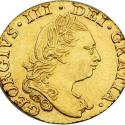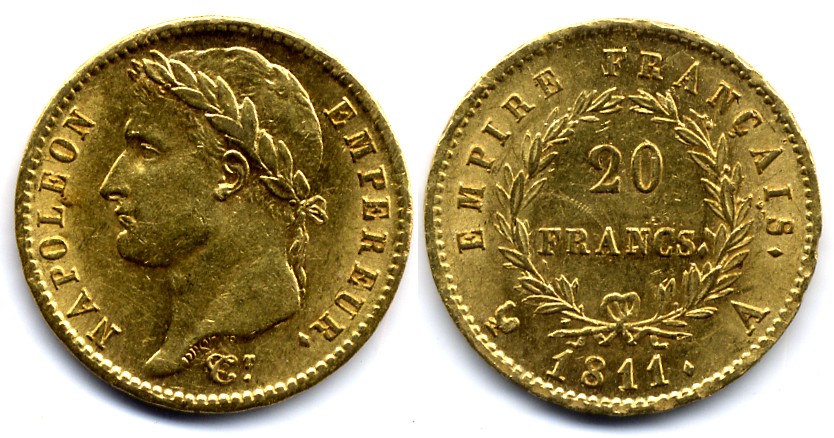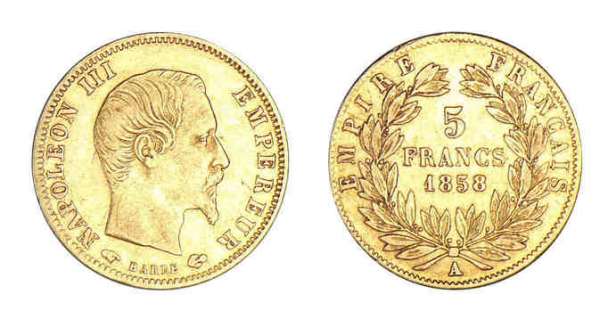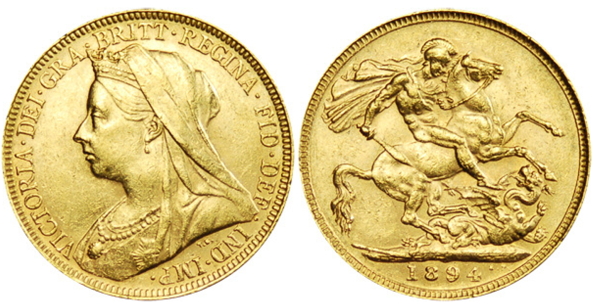A Scion Society of The Baker Street Irregulars

Glittering Golden Guineas (1951)
Editor’s Note: This article by noted Holmesian, Jay Finley Christ, is reprinted from The Numismatist, Vol. 64, No. 10 (October 1951), pp. 1103-05. I would claim that this was the first paper published with Sherlock Holmes – numismatic connections.
Glittering Gold Guineas by Jay Finley Christ
There is at least a spark of numismatic interest in two of the adventures of Mr. Sherlock Holmes of Baker Street, London. First, there is the “three-pipe problem” in The Adventure of the Red-Headed League. Holmes had deduced the projected robbery of a city bank. The prize was to have been 30,000 Napoleons of French gold, which Holmes at once evaluated at 30,000 pounds sterling.
 A search for the description of a suitable coin led me far from Baker Street and to the 20-franc gold piece. An extremely fine specimen of 1811 is about the same diameter and about two-thirds as thick as the coveted U.S. nickel, 1950-D. The weight of the 20-franc piece is 96 grains. The total collection would have weighed some 400 pounds avoirdupois, which would have been too much for the two small thieves without benefit of conveyance, of which there is no record. Again, the Napoleon’s value was $3.86, and the indicated number would have fallen some 6,500 pounds sterling short of Holmes’ evaluation.
A search for the description of a suitable coin led me far from Baker Street and to the 20-franc gold piece. An extremely fine specimen of 1811 is about the same diameter and about two-thirds as thick as the coveted U.S. nickel, 1950-D. The weight of the 20-franc piece is 96 grains. The total collection would have weighed some 400 pounds avoirdupois, which would have been too much for the two small thieves without benefit of conveyance, of which there is no record. Again, the Napoleon’s value was $3.86, and the indicated number would have fallen some 6,500 pounds sterling short of Holmes’ evaluation.
 To be sure, there is a 5-franc gold piece of Napoleon III, of which 30,000 would have provided two burdens of only about 40 pounds each, and their value would have been around $30,000. However, most Holmesian scholars do not accept the later as a solution, and so there is no solution at all to the “pretty little problem” of the 30,000 Napoleons. Even the thieves did not solve it, for they were taken before they laid hands on the loot.
To be sure, there is a 5-franc gold piece of Napoleon III, of which 30,000 would have provided two burdens of only about 40 pounds each, and their value would have been around $30,000. However, most Holmesian scholars do not accept the later as a solution, and so there is no solution at all to the “pretty little problem” of the 30,000 Napoleons. Even the thieves did not solve it, for they were taken before they laid hands on the loot.
Another curiosity appears in The Adventures of the Three Garridebs. Really, there was only one person by that name. He was a collector of antiques who aspired to be “the Hans Sloane of my age”; but one suspects that he was a mild sort of fraud, for we catch him casually polishing an ancient Syracusan coin with a chamois leather! Every coin collector’s primer points out the wickedness of this nefarious practice. The old boy should have known better. And yet, it may be that primers were not generally available in those days of 1902, or Mr. G. might have owned a Syracusan chamois.
 There are, in the Saga, occasional references to the shilling or the crown, but in most cases the monetary unit is the pound or its coined equivalent, the sovereign. Sherlock himself once took, as [a] fee for witnessing a wedding, a golden sovereign, which he promised to wear upon his watch chain. There is no evidence whatever that he did so, and I lost interest in this anyway in favor of four references to guineas.
There are, in the Saga, occasional references to the shilling or the crown, but in most cases the monetary unit is the pound or its coined equivalent, the sovereign. Sherlock himself once took, as [a] fee for witnessing a wedding, a golden sovereign, which he promised to wear upon his watch chain. There is no evidence whatever that he did so, and I lost interest in this anyway in favor of four references to guineas.
In The Adventures of the Resident Patient a young doctor’s professional career was financed upon the stipulation that three-fourths of his gross income should accrue to the capitalist. This latter pleasant character called upon the doctor every evening to inspect the books and then “put down five and three-pence for every guinea I had earned.” In The Adventure of Silver Blaze there was a dressmaker’s charge of 22 guineas for a lady’s costume.
In The Adventure of the Engineer’s Thumb young Victor Hatherly was promised a 50-guinea fee, though he never got it. Finally, in A Scandal in Bohemia Godfrey Norton, barrister, rushed from a house in great excitement and shouted to a cabman, “Drive like the devil! … to the Church of St. Monica … Half a guinea if you do it in twenty minutes.” Holmes and another person followed with similar requests, but they more frugally and more [orthodoxly] offered, each, only a half-sovereign.
Nowhere in the whole series of tales did a guinea, or a part of a guinea, actually come into sight, and only the cabman’s came even came close to it; but elsewhere in 19th-century literature the guinea was tossed about with great liberality and abandon. Even Silas Marner, poor weaver of Raveloe, had beneath the bricks under his loom, a shining hoard that consisted chiefly of golden guineas, brought out of an evening to clink and glitter as he handled them with his crooked fingers.¹ Thus, the Holmesian references merely served as a final prod toward an answer to a question long uneasy in the subconscious, “What were these guineas, anyway?”
 Gold guineas (there was no other kind) were coined from 1663 until 1813.² Minted of gold from the Guinea Coast of Africa by the Africa Company under special license of the Crown, these coins at first were silver, which was then the monetary standard.³ The relative values of gold and silver fluctuated from time to time, and at one period the guinea reached an exchange value of 30 shillings of silver;4 but by 1717, the official value had been set at 21 shillings, where it remains today. Even though the guinea, as a coin, was long ago superseded by the sovereign in 1817, the guinea remained a common unit of price quotation and of some kinds of fees and rewards.5
Gold guineas (there was no other kind) were coined from 1663 until 1813.² Minted of gold from the Guinea Coast of Africa by the Africa Company under special license of the Crown, these coins at first were silver, which was then the monetary standard.³ The relative values of gold and silver fluctuated from time to time, and at one period the guinea reached an exchange value of 30 shillings of silver;4 but by 1717, the official value had been set at 21 shillings, where it remains today. Even though the guinea, as a coin, was long ago superseded by the sovereign in 1817, the guinea remained a common unit of price quotation and of some kinds of fees and rewards.5
The guinea is somewhat astonishing to a modern eye accustomed to coins with raised rims. The edges are milled,6 but the coins, except the very latest ones, are somewhat thinner at their edges than they are in their centers, providing a sort of cameo effect.7 The legends fill the reverse and most of the obverse near the rim. For example, [the obverse reads] GEORGIUS III DEI GRATIA, [while the reverse is inscribed] M.B.F.E.T.H.REX.F.D.B.ET.L.D.S.R.I.A.T ET.E.1769.
The first “M” signifies “Magnae,” first used by King James I, who insisted upon Great Britain.8 A steel engraving of George I provides more information with the following: MAG. BRITANNIAE, FRANCAE, ET HIBERN. REX; FIDEI DEFENSOR; BRUN. ET. LUNEII. DUX; S.R.I. ARCH THESAU. ET ELECTOR.9 Since S.R.I. is the standard abbreviation of Sacri Romani Imperii, the legend, translated, reads: “George, by the Grace of God, of Great Britain, France and Ireland, King; Defender of the faith, of Brunswick and Luneberg, Duke; of the Holy Roman Empire, High Treasurer and Elector.”
The third and fourth phrases are strictly Hanoverian. The fourth goes back to the first firm connection of Hanover to the Holy Roman Empire. In 1692 Ernest Augustus, duke of Brunswick and Luneberg (Hanover), made certain extravagant promises to the Emperor, and in return Ernes was made standard-bearer of the Empire and, at the same time, was appointed ninth (and brand new) member of the group of German princes whose prerogative it was to select the Holy Roman Emperor.
These appointments produced no great enthusiasm in the other prince-electors. In fact, they did not admit their validity until 1708, when George Lewis became GEORGIUS, by Grace of God, King of Great Britain, etc., he just carted his Hanoverian titles along and put them on the coinage of England, along with the royal arms of Hanover.
Remains now only the discrepancy between standard-bearer and arch thesaurus. Somewhere along the line, the office of Imperial Treasurer of the Empire was transferred from the Palatinate to Hanover. The date seems obscure, but the A.TH. on coins of 1714 seem to indicate that George, or his mintmaster, must have believed he was entitled to it at that time.10
This elaborate legend of the Georges ornamented the coinage of England somewhat less than a hundred years. It last appeared on the so-called “spade guinea”11 of 1799 and the spade half-guinea of 1800. The Garter, or military, guineas of 1800-1312 bore a simple legend. [The obverse read] GEORGIUS III DEI GRATIA, [and the reverse], BRITANNIARUM REX FIDEI DEFENSOR, with the arms of Britain, Ireland, Scotland and Hanover, and with the Garter and its famous motto. Never again did the monarchs of Britain on their coinage profess any claim to the throne of France. One wonders that they had not abandoned such claims precipitately on, say, January 22, 1792, when news reached them of certain events in France on the 21st.
The legend itself was substantially unchanged until 1893, when IND. IMP. was added to it; but the arms had been altered upon the accession of Victoria in 1837. Under the Salic law, a woman could not ascend to the throne of Hanover, and so the arms of Hanover were no more seen on the coinage of England. But the story of the arms on the coinage is for another telling, if it has not been told already.
NOTES
- Holmes would have known Silas by his tooth, as was said in The Adventure of the Copper Beeches. Will someone tell me what happens to a weaver’s tooth? Silas never mentioned it. Does he wear it down by woofing warps? Or What?
- This date was astonishing. Guineas must have been plentiful or durable, for they are not difficult to get, even now.
- The Guinea Coast gave its name to the coin that never has borne any mark of its value or denomination. The earliest ones bore a tiny elephant, or elephant and castle (the marks of the Africa Company). For this and other details, see Spink, The Milled Coinage of England, where all of the coinage since the Commonwealth is fully illustrated and described.
- Encyclopedia Britannica article, “Guinea.”
- Objects of art, racing prizes and a few other things still are priced in guineas. A bill from Spink and Son for a half-guinea reads “1 ½, ₤1 1s.’
- Or reeded, or grained, or maybe knurled. Experts seem to disagree.
- A quarter-guinea of George I, 1718, has a real raised edge, and one or two others approach it, but only on the reverse. The military type, 1800-1813, has a raised rim, but the center of the coin on the obverse is higher than the rim.
- Encyclopedia Britannica article, “Great Britain.”
- Gardner, History of England, p. 03, from an engraving by Vertue.
- Encyclopedia Britannica article, “Elector,” gives the date as 1778. This may be a misprint for 1708. No other authority is available at the moment.
- So-called because of the spade shape of the coat-of-arms. The spade has a very short handle.
- As did the guinea of 1813. No guineas were coined between 1800 and 1813
 Jay Finley Christ (1884-1963) was a professor of law at the University of Chicago (1920-1950) and eminent Holmesian. He is famous for having invented the system of 4-letter abbreviations to shorten the titles of the 60 adventures of Sherlock Holmes, which was published for the first time in his book: An Irregular Guide to Sherlock Holmes of Baker Street (1947). This system is still used today.
Jay Finley Christ (1884-1963) was a professor of law at the University of Chicago (1920-1950) and eminent Holmesian. He is famous for having invented the system of 4-letter abbreviations to shorten the titles of the 60 adventures of Sherlock Holmes, which was published for the first time in his book: An Irregular Guide to Sherlock Holmes of Baker Street (1947). This system is still used today.
Reproduced courtesy of THE NUMISMATIST, official publication of the American Numismatic Association (www.money.org)

[…] Glittering Gold Guineas by Jay Finley Christ. Possibly the first article written (1951) to combine Sherlock Holmes and numismatics, it has a nice discussion about those 30,000 gold Napoleons in the bank vault. […]